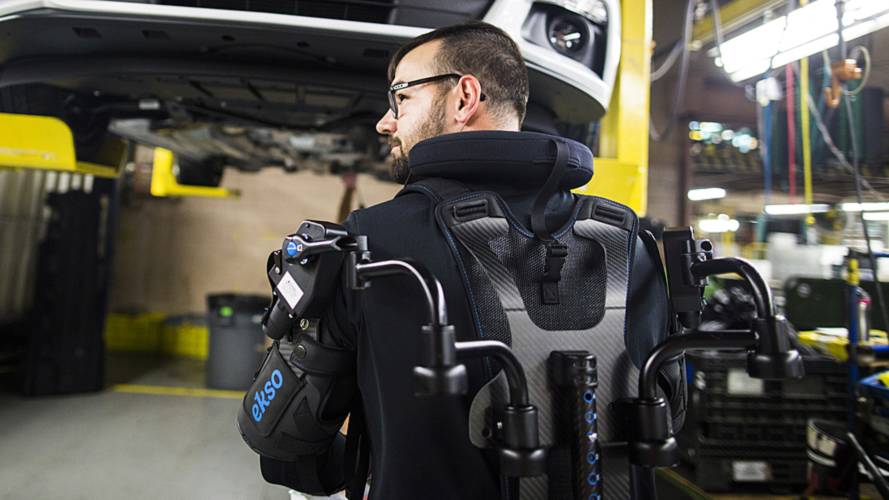The incredible potential of digital technologies is transforming the workplace, but what does this mean for workers’ health and safety?

Digitalisation offers the potential for innovative and exciting developments in the workplace, but
also presents new challenges. By anticipating the potential challenges for occupational safety and
health (OSH), we can maximise the benefits of such new technologies, while ensuring that working environments are safe. If well managed, digitalisation can reduce occupational risks and create new opportunities for improving working conditions.
The development of digital technologies, such as artificial intelligence (AI), advanced robotics, widespread connectivity, the internet of things and big data, wearables, mobile devices and online platforms, is changing the nature and location of work, who works and when, and how work is organised and managed. Digital technologies now provide essential services to all sectors of our economy and society. These developments can create new challenges for OSH and its management. The rate at which these developments are taking place is faster than ever before.
Robots are becoming mobile, smart and collaborative. Intelligent machines are taking over a wide range of not just manual but also cognitive tasks previously done by humans. Workers are increasingly overseen by monitoring technologies and algorithms, to the extent that in the future they could be managed by intelligent machines.
The 24/7 globally interconnected economy requires ever more flexible work organisation and has given rise to new forms of work, such as online platform work. In this context, psychosocial and organisational risk factors deserve particular attention, as they may give rise to higher levels of work-related stress and poor mental health. New safety and ergonomic challenges are emerging as well, including risks of functional safety associated with cybersecurity. Last but not least, digital technologies and new forms of work present challenges for the application of OSH regulations.
Advances in digital technologies are inevitably shaping our future. From increasingly sophisticated robots that replace workers in customer-facing roles to additive manufacturing technologies (3D printing) that produce human organs, the potential of innovations in digitalisation to meet growing demand and increase productivity is vast. However, increased levels of automation and the constant monitoring of workers by digital technologies will in many cases reduce person-to-person contact and increase performance pressure, with potentially detrimental effects on workers’ mental health.
Smart cobots
Collaborative and smart robots, so-called cobots, will become a familiar presence in the workplace as highly developed sensors make it possible for people and robots to work together. Amazon already has 100,000 AI-augmented cobots supporting its distribution activities. Most cobots are equipped with self-optimising algorithms, allowing them to learn from their human colleagues. With the increasing use of AI, robots will be able to carry out not only physical tasks but also increasingly cognitive tasks.
Robots are already able to perform a variety of cognitive tasks autonomously, such as supporting legal casework or medical diagnoses, and will also become commonplace in customer-facing jobs. This means that the use of smart robots is expected in many different sectors and settings, such as in the care sector, hospitality, agriculture, manufacturing, industry, transport and services.
Robotics allows us to remove workers from hazardous situations and improve the quality of work by handing repetitive tasks to fast, accurate and tireless machines. Cobots can also facilitate access to work for many people who are currently excluded, for example by supporting disabled people or ageing workers in the workplace.
However, the growing proportion of mobile, smart robots in the workplace may increase the risk of accidents, as injury could occur from direct contact with robots or from the equipment they use. As smart robots are constantly learning, although efforts are made to factor in all possible scenarios in their design, they may behave in unanticipated ways. Workers having to keep up with the pace and level of work of a smart cobot may be placed under a high level of performance pressure. This may have negative impacts on workers’ safety and health, particularly mental health. Increased working with robots will also significantly reduce contact with human peers and social support, which is also detrimental to workers’ mental health.
Exoskeletons
New body-worn assistive devices, so-called exoskeletons, have been introduced in some workplaces to support workers carrying out manual handling tasks while reducing the load on the muscular system. While the extent of their broader deployment is still unclear, exoskeletons have already proven to be beneficial in specific settings, such as for military applications or in medical care settings.
Although the potential benefits of exoskeletons to support workers with physical impairments or to prevent work-related musculoskeletal disorders could be of value, it is also necessary to take into account that such assistive devices give rise to new concerns in relation to OSH. The long-term effects of exoskeleton use on physiological, biomechanical and psychosocial parameters are unknown. And, in fact, according to the hierarchy of control measures, collective technical and organisational prevention measures should always be considered first and individual technical prevention measures such as equipping a worker with an exoskeleton are seen as the last resort.
Big data, artificial intelligence and algorithms
Mobile, wearable or embedded (in the clothes or body) digital monitoring technologies are increasingly used to monitor workers in real time. Work is increasingly overseen and coordinated by algorithms and AI based on big data, tracking data on workers’ productivity, location, vital signs, stress indicators, micro-facial expressions and even tone and sentiment analysis. About 40 % of human resources (HR) departments in international companies now use AI applications and 70 % consider this a high priority for their organisation. According to a survey of senior executives in a number of sectors and industries around the world, more than 7 out of 10 think that it will be common to use AI to evaluate workers’ performance and set rewards in the next 10 years, but as many as 4 out of 5 would not be comfortable with an intelligent machine managing them.
Pervasive monitoring allowed by AI-supported digital monitoring technologies can have a negative impact in particular on workers’ mental health. Workers may feel that they will lose control over work content, pace and scheduling and the way they do their work, that they are unable to interact socially or take breaks when they want to, and that their privacy is invaded. The use of data for example to reward, penalise or even exclude workers could lead to feelings of insecurity and stress. To prevent this, it is important to ensure transparency in relation to the collection and use of such data. New types of smart monitoring tools may also provide an opportunity to improve OSH surveillance, support evidence-based prevention and increase the efficiency of inspections.
Smart personal protective equipment
Mobile miniaturised monitoring devices embedded in personal protective equipment (PPE) allow real-time monitoring of hazards and can be used to provide early warnings of harmful exposures, stress, health problems and fatigue. Real-time advice tailored to the individual can be provided to influence worker behaviour and improve safety and health. Information could also be collated and used by organisations to help predict potential OSH problems and spot where OSH interventions at organisational level are required. However, effective strategies and systems and ethical decisions are needed in the context of handling the large quantity of sensitive personal data that could be generated. A malfunction, or the generation of incorrect data or advice, could also cause injury or ill health.
Virtual reality and augmented reality
Virtual reality (VR) and augmented reality (AR) offer the advantage of removing many workers from hazardous environments, as they can be used for example to support maintenance tasks and for immersive training. AR could also provide contextual information on hidden hazards, such as the presence of asbestos, electricity cables or gas pipelines. But the reliability of AR is dependent on maintaining access to sources of relevant, high-quality information and on whether or not it is up to date. VR and AR devices may also be a source of risks because of distraction, information overload, disorientation, motion sickness and eye strain.
Additive manufacturing
The use of 3D printing will become more commonplace. Bio-printing is increasingly being used to produce biological products or organs. Advances in 3D printing capabilities will create great opportunities, with the addition of a fourth dimension expected to enable the production of materials that can change with time. All this comes with incredible potential, but possible new risks to workers’ safety and health as a different population of workers is exposed to manufacturing hazards and dangerous substances, including dust, in decentralised, small, even micro, companies. As items produced by additive manufacturing are often one-offs, OSH standards are also difficult to define or enforce.
Mobile digital devices
Digital mobile technologies and widespread connectivity offer the opportunity for increased flexibility and a better work-life balance. But they could also mean an increase in the demand for permanent availability, irregular working hours, blurred boundaries between work and private lives, and precarious forms of work.
The global reach of mobile digital technologies is a key driver of the 24/7 economy. People no longer need to be in the same location to communicate and exchange information. Flexible working environments are increasingly becoming the norm, facilitating a high degree of flexibility in working hours. Although this presents attractive possibilities for workers and the economy, there are potential safety and health risks. The balance mainly depends on whether the flexibility permitted by mobile working offers a real opportunity for workers or is imposed by the employers for their own benefit.
The main OSH concerns are associated with the fact that workers are likely to experience an increased workload, excessive working hours and an unhealthy work-life balance. Lone working and the feeling of isolation, the lack of collective support and problems related to reduced support from the organisation are also issues.
Musculoskeletal disorders may also become more likely as flexible working environments and mobile digital technologies become commonplace. This presents a significant challenge for OSH, as many such environments are not ergonomically suitable, but employers have little control over them. Health problems such as obesity, type-2 diabetes and cancer may also become more prevalent as digitalisation increases sedentary working.
As workers become more dispersed and diverse, with 24/7 flexible working becoming the norm, overseeing and regulating OSH could become more challenging. With business hierarchies changing and many workers either managing themselves or being managed remotely or by AI, there is likely to be a loss of clarity about who is responsible for OSH and how it should be overseen and regulated.
Online platforms
Online platforms create new business models by matching demand for labour with its supply. They can facilitate labour market access for vulnerable groups and provide a regulatory opportunity to address undeclared work. Online platform work comprises a variety of working arrangements — generally ‘atypical’ in some way — different types of jobs and many forms of nonstandard employment, from high-skilled work carried out online to service work carried out in people’s homes or other premises and managed via web-based applications.
Consequently, working conditions also vary significantly and so do the OSH risks, as they depend on the various specific work activities themselves. However, OSH risks are likely to be aggravated by the specific features of online platform work. These include work requests issued at short notice, penalisation for not being available, the fragmentation of jobs into tasks with narrower job content and subject to continuous evaluation and performance rating. Further pressures result from increasing competition as the online labour market becomes global and accessible to more workers, irregular working hours, blurred boundaries between work and private lives, unclear employment status, insecure income, no training opportunities, no social entitlements such as sick pay and holiday pay, poor worker representation and lack of clarity in terms of who is responsible for OSH.
Online platform work offers the benefits of flexibility in terms of working time and place of work, but, in many cases, this flexibility is imposed on the worker. Workers in non-standard, poor-quality forms of work tend to have poorer physical and mental health. The online platform economy also creates new challenges for labour protection and OSH management, and there are key questions around the responsibility for and regulation of OSH. In most Member States, the application of OSH legislation depends on an employment relationship, which is more difficult to establish in the context of specific features of online platforms, such as the triangularity of the parties involved and the temporariness, informality, autonomy and mobility of the work.
How can we address the challenges and maximise the opportunities for safety and health at work?
Digitalisation will bring new and emerging OSH challenges, but also opportunities. Swaying the balance towards the opportunities will depend on how the technology is implemented, managed and regulated.
Digital technologies can advance OSH efforts in a variety of ways, for example by allowing the removal of workers from hazardous working situations, through innovative ways of monitoring exposure, or by improving the quality of work by relieving workers of repetitive or routine tasks.
Digital technologies and new forms of work may also permit workers to benefit from higher levels of autonomy and flexibility, or facilitate the access of a more diverse workforce to the labour market, in particular vulnerable groups such as disabled people, ageing workers and those with care duties at home. Digitalisation also offers opportunities for more effective OSH training, advanced workplace risk assessment, communication and OSH inspections.
However, depending on how technologies are designed and implemented, on the organisational context and on the employment status, digitalisation may result in some workers being more exposed to OSH risks such as ergonomic and safety risks, including functional safety risks associated with cybersecurity. Increased organisational and psychosocial risks, with an increase in work-related stress and poor mental health, could also be a consequence of increasing performance pressure and work complexity, irregular working hours, less social interaction and support at work, blurred boundaries between work and private life, and new forms of work with unclear employment status. Digitalisation of the world of work also challenges and reveals gaps in current mechanisms for managing and regulating OSH. This may be the case for example for certain forms of work facilitated by online platforms or in situations where workers are managed by intelligent machines.
Digital technology in itself is neither good nor bad. Maintaining a balance between the challenges and the opportunities presented by digitalisation depends on the proper application of technologies and how they are managed and regulated in the context of social, political and economic trends such as workforce demographics, the state of the economy, social attitudes, governance and skills.
Examples of OSH strategies that could help to mitigate the OSH challenges presented by digitalisation include:
• the development of an ethical framework for digitalisation, codes of conduct and proper governance;
• a strong ‘prevention through design’ approach that integrates human factors and worker-centred design;
• the involvement of workers in the design and implementation of any digitalisation strategies;
• collaboration between academics, industry, social partners and governments on research and innovation in digital technologies to properly take account of the human aspects;
• a regulatory framework to clarify OSH liabilities and responsibilities in relation to new systems and new ways of working;
• an adapted education system and training for workers;
• the provision of effective OSH services to all workers of the digital world of work.




